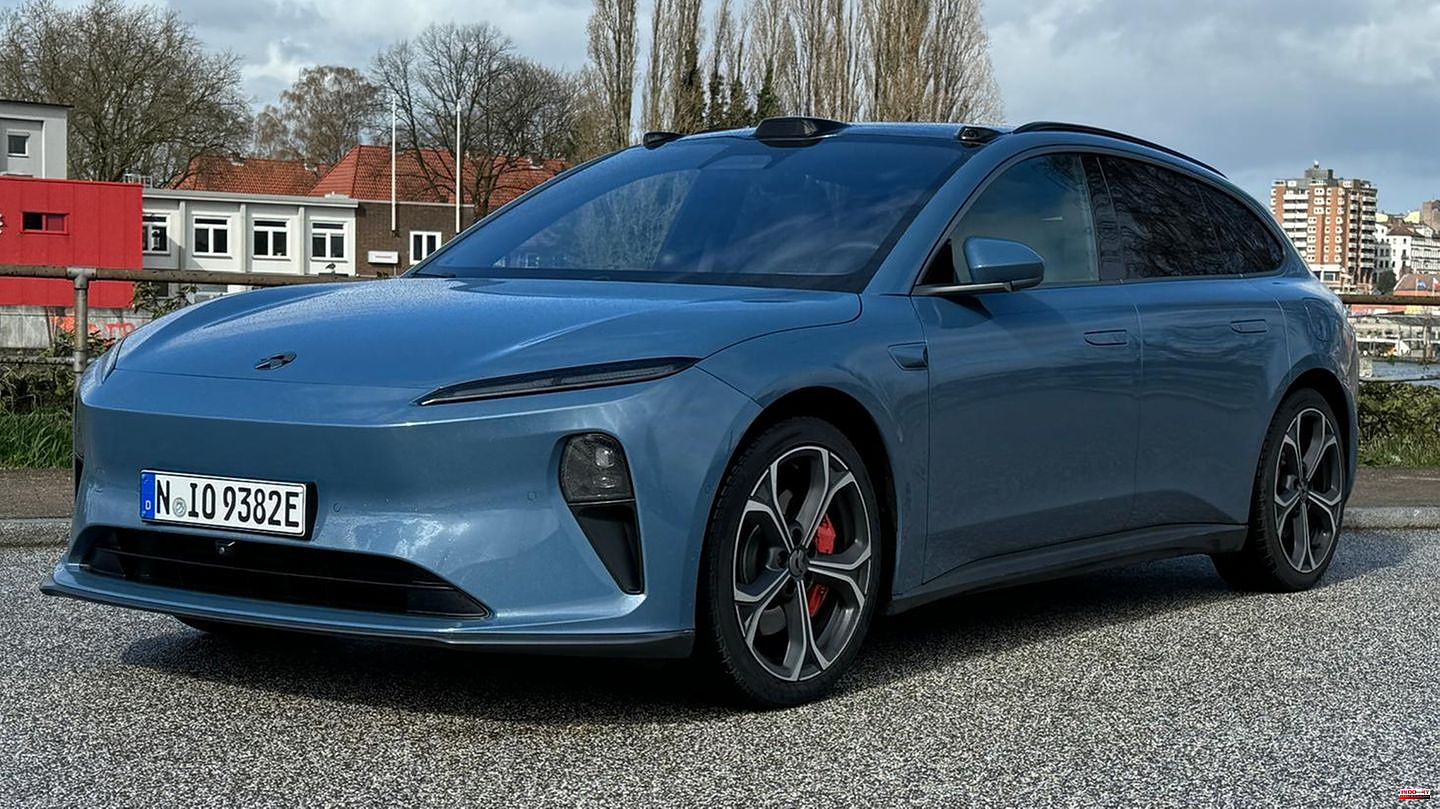Nio is a young company. The Chinese start-up was founded in 2014 and still manages to stand out from the crowd of Chinese car manufacturers. Because Nio is trying what even Renault has already failed at: alternatives to staying at the charging station. At the same time, Nio builds rock-solid cars with which the brand positions itself broadly on the market. But maybe it's too wide.
First of all, the car: The stern test gave us the opportunity to test the Nio ET5 Touring, an electric station wagon with a large battery, for two weeks. The ET5 is one of five vehicles from the manufacturer's current range that are visually very similar. Because Nio has developed its own design language, which, with minor exceptions, is very pleasing. This is particularly true for the station wagon, whose body shape is extremely popular in Germany and is still relatively rare as an electric car.
The Nio is really beautiful. The slightly pinched headlights, the long, tapered hood and the streamlined design attract attention - and receive a lot of praise. The rear of the station wagon is also really well done. And actually so beautiful that you could choose this model just for the sake of its appearance. If you didn't know better, it could be a shooting brake, i.e. a coupé with a hatchback.
The impressions continue in the interior. The Nio ET5 Touring is equipped with a consistently high-quality interior, the workmanship of which leaves nothing to be desired. The material mix is already in this "middle class", where Nio classifies the car itself, on a par with a BMW 3 Series or a Mercedes C-Class, and actually even with the models above.
The numerous comfort functions underline this. Whether it's scenting, seat cooling or heating, heated steering wheel, surround system, ambient lighting, huge panoramic glass roof or even a massage function for the driver and front passenger - the ET5 has all of this on board as an option or even as standard.
Nomi is also on board as a small USP (Unique Selling Point), as unique sales arguments are often called. This is the voice assistant from Nio, which optionally sits on the dashboard as a small, always in a good mood robot ball and supports and cheers you up with funny gestures as well as practical functions.
Despite all the luxury, Nio hasn't forgotten the driving characteristics: 490 hp drive the car forward, and the 2.2-ton station wagon sprints to 100 km/h in 4 seconds. As standard, the car is powered by a 75 kilowatt-hour battery; for an additional charge of 9,000 euros, the car is also available with 100 kWh. In the standard range, the car has a range of 435 kilometers according to the WLTP standard, with the large battery the range is 560. By the way, you don't have to buy the battery - Nio also offers the heart of the vehicle in a rental model, more on that later.
The manufacturer's range information is, like others, quite optimistic. In the test, the vehicle had a 100 kWh battery and the range was around 450 kilometers. This is due to the comparatively high consumption. In a third mix of city, country road and highway driving, the car achieved around 24 kilowatt hours per 100 kilometers. If you only drive on the highway at a slow speed of 130 km/h, it will be over after just over 300 kilometers. The manufacturer's specifications can probably only be achieved under unrealistic conditions without any driving comfort. If you sprint away at the maximum possible 200 km/h, you can watch the battery drain.
As a station wagon, the Nio naturally offers a lot of space. The squat shape limits the volume somewhat, but the trunk still has 450 liters. If you fold down the back seat, it's 1247 liters. But you have to complain once: If you try to sink the supplied bag with all the cables into the false floor of the trunk in one go, you will fail. The cable only fits if you lay it out naked and as wide as possible. Shouldn't you just put it in the frunk, i.e. the front storage space? It doesn't work, it doesn't exist.
The sloping rear is also more disadvantageous in terms of visibility. You can't see too much of the ET5 Touring when you look over your shoulder. Without the many cameras you would probably be quite lost when parking. By the way, the cameras are positioned very prominently on the car – some might even call the structure “horns”. You have to like it. The Nio ET5 Touring also has a very pleasing towing capacity of 750 kilograms unbraked and 1.4 tonnes braked. You can imagine what that does to consumption. But the electrically extendable (!) trailer hitch makes the Nio a useful and thoroughly comfortable cargo donkey.
As far as the trip itself is concerned, nothing is left to be desired. The performance, steering and chassis are extremely pleasantly tuned, with a tendency towards comfortable cruising. But the Nio can also be sporty, and no complaints were noticed in the test.
Of course, the software plays a major role in a car like this. The in-house Banyan operating system is impressive; navigation, operation and menus can seem a bit convoluted at first, but are largely internalized after a short learning process. Nomi is only of limited help - apart from a few standard commands, she often reacts to commands with striking ignorance. Conversation or context-based input is not possible.
What's missing is a connection to Apple or Android smartphones. It is almost impossible to set up more than one Bluetooth connection for phone calls, which in many cases are noticeable due to poor voice quality at the other end. There is no Carplay or Android Auto, only Spotify is available as a vehicle app, which makes it easier to use.
The lack of options to use your own navigation solutions, such as Waze or Apple Maps, means that you have to rely on the onboard navigation system, which makes sense for electric cars anyway due to charging planning. But: While all cell phone apps in the test had already taken into account the elimination of a closure on the chaotic A7 near Hamburg, the Nio assumed until the end of the supposedly closed route that it was impossible to drive along. According to the vehicle, the detour would have taken about an hour - not a good achievement if you are not prepared to allow alternatives. This needs to be improved.
The vehicle's assistance systems on the highway are limited to an adaptive cruise control or the pilot, who is able to change lanes independently after activating the turn signal. This works well thanks to the 33 built-in sensors, the car doesn't miss anything, which can be easily seen on the display on the steering wheel. It would be conceivable that Nio has already prepared for semi-autonomous driving with this camera and sensor arsenal - the hardware would be there. Lack of software and legal framework.
The operation of the assistants is debatable. There are only two fairly identical universal keypads on the steering wheel, which trigger different functions depending on the situation. As with the nested display menus: once you understand it, it's easy to use. Luckily there are still the classic levers for windshield wipers, lights and indicators.
Unsurprisingly, the car also uses the many eyes to protect the body from damage caused by accidents or parking mistakes. Almost every maneuver is monitored with centimeter precision, but this is urgently needed due to the poor visibility to the rear.
As usual, there is also an app for the Nio ET5 Touring in which you can get various information about the vehicle and trigger a handful of functions. There is a community and a kind of social network connected to it - this may seem strange, but it is quite popular in China. In the test, the app ran very reliably and even reported once that a window was still open - which could conveniently be closed remotely.
The Nio ET5 cuts a mediocre figure at the charging station. This is especially true when charging on an AC column. With a 100 kilowatt hour battery, “refueling” with 11 kW is really slow. Things look much better on a direct current column. Nio promises up to 180 kilowatts of charging power here. In the test, however, the Nio only achieved a peak of 123 kilowatts, which suggests that an older battery model was previously plugged into the changing station. The fast batteries haven't been around for very long. Charging from eight to 80 percent took 38 minutes. With a newer battery it would be under 30.
The position of the charging port is extremely inconvenient. It is gradually becoming clear that a tailgate on the rear left, i.e. on the driver's side, is probably the worst choice. On the street you stand on the road in the direction of travel, some fast chargers are best reached by parking forward (McDonald's!) - in both cases the position is annoying.
But you don't even have to bother with the cable - at least if you live in central, western or southern Germany. With currently eleven swapping stations, called Nio Power Swap Stations, it is possible to shorten the charging time from 0 to 100 percent to around five minutes. You just drive to one of the locations, register the change and the car drives fully automatically into the garage-like station, it rumbles briefly and a little later it continues at full power.
In the test, this was achieved almost straight away, even if it only became clear what to do on the second attempt due to the lack of signage. The car actually guides you through the changing process with numerous announcements, but to be honest it can all be a bit overwhelming. The changing stations also have fixed opening times - changing at night is not possible; in Germany it is closed from 7 p.m. This is because there is always an employee on site to help customers who have problems with the switch. The test required English language skills, which can be particularly problematic for older customers.
The car manufacturers’ big goal of “charging like refueling” is already a reality here today. But it comes at a price and only works under certain circumstances. In addition, there is currently a gigantic northern German hole in the network from Hanover and Schipkau. This unique selling point will only really become suitable for everyday use in the future, should Nio further expand the network.
It looks like that at the moment, but building the stations is certainly not cheap and at the same time the loading times are becoming shorter and shorter. Porsche is already at 18 minutes for the 10 to 80 percent window. Since you sometimes have to wait at a power swap station, the swap would no longer make sense if there was a queue of three cars with the highest possible charging capacity. Even with 180 kilowatts, Nio's current top output, the exchange is only worthwhile if the detour to the station including the exchange does not exceed half an hour. Everyone has to calculate for themselves how often this happens.
Another problem with Nio and said unique selling point is the restriction for buyers. If you decide to pay for the car in full, including taking over the battery, Nio excludes the vehicle from the battery replacement. Only those who rent the battery despite purchasing the vehicle (169 euros per month for 75 kWh, 289 euros per month for 100 kWh) get access. The exchange is free twice every month, after which the charge is made per exchange per kilowatt hour.
At the beginning there was talk of the fact that it can't be because of the cars that Nio is selling hardly any significant numbers and is stumbling economically. The test confirms this several times. The Nio ET5 Touring is a thoroughly great car with many advantages and very few weaknesses, most of which could be remedied with an update.
But a look at the prices reveals why it could fail. For the ET5 Touring with the absolute basic equipment (which is already quite generous), you currently have to pay 47,500 euros without the battery. If you press a few buttons in the configurator, for example to recreate the test vehicle, the price shoots up to 75,500 euros with a purchased battery or 54,500 euros without a battery, but with a monthly rental charge of 289 euros.
That is, with all due respect, very expensive, even if the ET5 Touring can easily compete with a 5 Series BMW and is actually above its class. For a relatively unknown manufacturer that is positioned alongside established premium manufacturers, selling is certainly not an easy task - especially since the dealer and workshop network is currently very thin. After all, expansion is underway here too.







